| Lista Light |  |
Fishguard (Wales) to Isle of Jura (Scoland)
It’s 3.30 am and we pull Lista’s anchor from its Fishguard bed and leave Cardigan Bay to slosh up St George’s Channel and the Irish Sea. Contrary to the force 4-5 winds predicted, hardly a breath of wind tickles the sails.
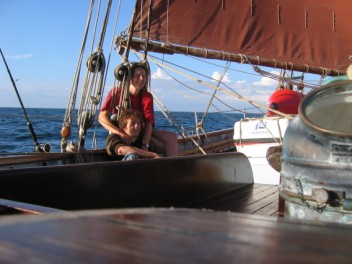
Platoons of manx shearwaters, gulls, guillemots and occasional gannets drift passed. Then finally, razor bills, our first sighting since starting our voyage. They are auks, cousins of puffins and guillemots, with broad black bills with a white stripe.
If you were to journey back a hundred years to a peat fire, which you are huddled beside, under a turf roof on a Hebridean island. You might well have found yourself dining on a puffin, a shear water or other such marine bird. They were considered delicious by the local crofters and fisherman and would likely have been easy quarry as they were yanked from the entrance to their burrows as they returned at night to their broods. Sea bird eggs were also highly prized and collected from squawking colonies with the odd meaty squab. Other maritime countries have similar traditions including Norway and New Zealand where ‘mutton birds’ (shearwaters) can still be harvested in controlled numbers.
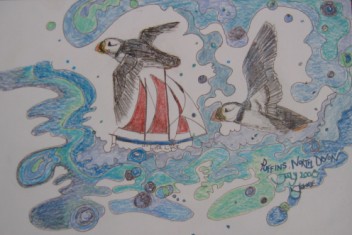
We slip into the night, preferring another night’s watch as the shipping forecast is favourable and the thought of mooring Lista in the dark is not. Clare and I rotate, ‘Three hours on, three hours off’, with David snatching the odd shut-eye on the engine house (like a slumbering dolphin with one eye open).
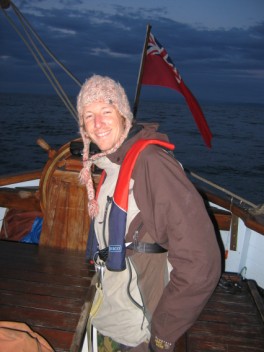
The ‘shipping forecast’ has taken on a whole new meaning. Previously, Radio 4’s familiar dulcet tones filling the airways had been reassuring, lyrical, but imperceptible. Now the shipping areas are real, the announcements received with gravitas. We hang on each word in case ‘force 8’ or ‘rough’ should make an appearance.
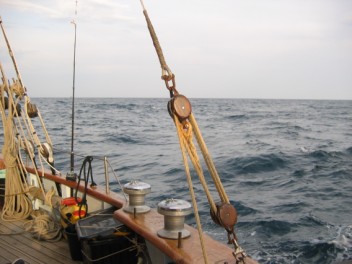
Dave radios the Hollyhead harbour master to inform him that we will not be arriving as previously reported. He replies that, ‘Force 8 and rough seas’, are indeed imminent. Taken off guard, we have no choice but to keep sailing and head for the Isle of Man. Huge ships emerge from the darkness and bare down on us, leaving glinting Merseyside behind for glinting Ireland. The night is wild. Winds howl in Lista’s sails and waves bash her sides. I brace myself against the helm, muscles strained, peering into the crashing darkness, desperate for daybreak to relieve the storm.
By the morning, the sea is a cauldron of frothing waves and certainly not receding. We snatch a glimpse of land before it disappears behind a pea soup of fog. Dave screams orders over the noise of the crashing waves to lower the mainsail and finally the staysail. I swallow back lumps of bile, grabbing madly at sails and then mooring lines, as Lista smashes through the waves. Finally, the break water of Douglas harbour appears out of the gloom and then suddenly calm.
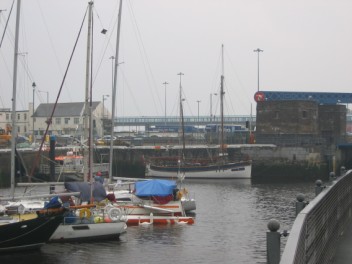
After some fraught manoeuvres by a platform that was drifting from its mooring by the harbour wall and being pierced in the bulwarks by the tug boat, we negotiated a calmer sight for Lista and squeezed under a bridge and into the main marina.
Shattered after the night’s ordeals, we slide ashore like a trio of dismembered ghosts. The land greets us in a turmoil of its own, rocking at our every footfall. I slink into an internet cafe in an attempt to work, but achieve zilch. Dave finds the chandlery, but with mouth ajar like a goldfish and eyes glazed over, is marched out, ‘Get some sleep and come back later.
So that’s where I find him, back aboard Lista. Miraculously, Clare is buzzing and steps off under the light of the moon in search of a local and her steak and chips fix.
On our brief walkabouts we find that he Isle of Man is in inhabited by a hotch-potch of incomers: the Scottish, Liverpudlian, Yorkshire and Geordie accents are scattered through its streets.
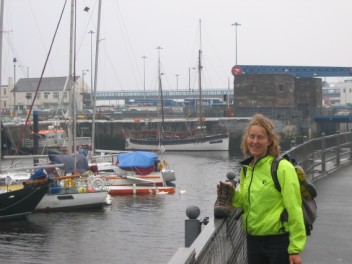
The next day David and I head for the hills, darting along tracks and up to the cliffs. The wind claws at our hair and the cliffs tumble down to a pewter sea. As we dash through the gorse fields, two choughs alight, pinging words to one another. I haven’t seen one of these Cornish sentinels for at least a year.
Choughs share the corvid family tree, amongst the crows and jackdaws. They are distinctive in having a red, fine, curved beak when adults. They haunt cliffs and mountainous areas, clattering through the air with their mates, sometimes seemingly ‘playing’. Like many of the ‘black birds’ they are best recognized when on high by their sharp, ‘whizzing’ calls.
The thing about choughs is that they disappeared from Cornwall where they had been wide spread before the mid 1900s. A whole Cornish folklore had built up around them and they were even emblazoned on the Cornish flag. They were a symbol of Cornwall’s rugged and spectacular coastline.
The RSPB amongst others were concerned and started to manage the cliffs to ensure that there was available habitat for choughs to survive. Choughs require short turf, grazed by sheep or cattle where they can use their sharp beaks to prize out leather jackets and other invertebrates. Cow pats are particularly useful reservoirs for such fodder. Gradually, the correct grazing regime was created and then, miraculously, one day a wondering chough stopped by! The RSPB suggest that it could have been a French juvenile looking for new habitat to occupy. Since then, the population has increased thanks to specific management by farmers and the work of the RSPB.
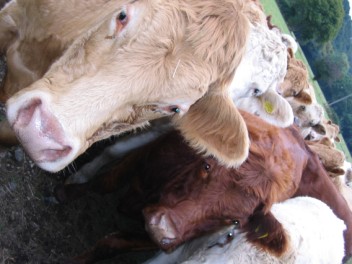
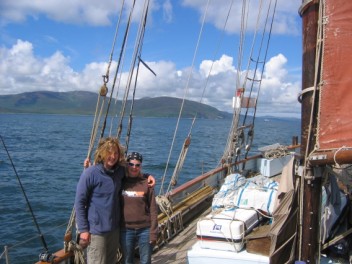
We leave the Isle of Man on calm seas and track North, gliding passed fishing villages and remote cliffs under a thousand stars. One morning, we miraculously tune into Radio 4 and the Farming programme heralds Dave’s brother, Ross, chatting about his work in Northumberland. He has been part of a project reintroducing salmon to the River Tyne and providing interpretation for the general public.... It is most extraodinary being transported home through the radio waves aboard the salty waves...
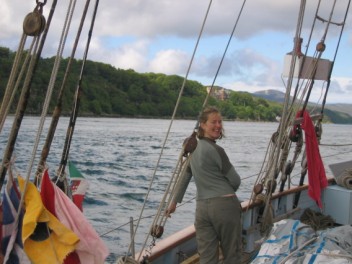
I awake to the Sound of Isla and land closely flanking Lista on either side. Perfect winds and a mighty tide swish Lista through the channel at 10.6 knots, her fastest yet. David basks in glory. A whisky refinery reminds us that we are near to the origin of some of Scotland’s finest, smoky malts.
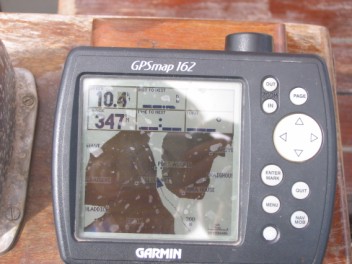
A flaming sunset streaks across the sky and leaks pink, umber and fiery orange across a Jura sky. The colours recede and expand, morph and consolidate for what appears to be hours. David swears that if you stare at the sun religiously, with unblinking focus, in a completely clear sky, just as it tips over the horizon, a green flash ignites the sky. What does it mean? Did ancient mariners seeing the flash believe their impending doom was sealed? Or perhaps it marks the birth of an incredible being who will change the world......?
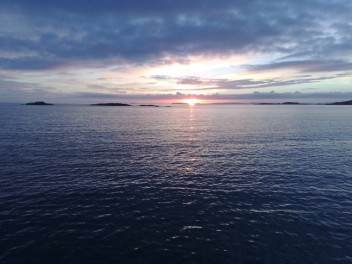
A huge, eighty strong flock of oystercatchers wheel above the beech turning from side to side, breaking up and then reforming.
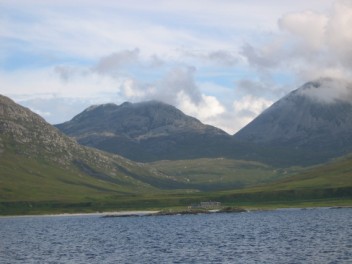
We pull back the hatches to an incredible view of verdant hills, Loch Tarbert lapping at Lista’s petticoats. The oystercatchers have awoken and are in full throttle darting around the beach and shrieking at one another. They are a ubiquitous bird along the UK’s coastlines, whether mud flat, beach or shingly inlet, they are likely to be disturbing the peace. They are part of the ‘waders’ clan with specialised beaks and fairly long legs, including, plovers, avocets and godwits.
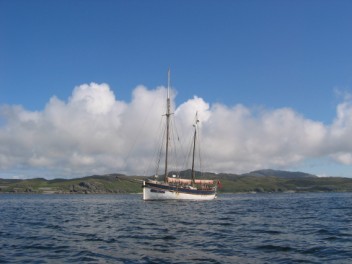
Oystercatchers as their name implies have a beak that is perfectly adapted to hammering and opening such prey as oysters, mussels and cockles. During the summer, you may also find them in upland areas where they will lay their mottled eggs on a scrape by a boulder strewn river.
What we think are boulders are in fact fat seals slumped over on an island enjoying the sun. Rock no.2, Shag Street, is hanged with shags and cormorants, pinning back their wings to dry and taking the odd peck at one another. A single great black backed gull sits like a turkey as their sentinel.
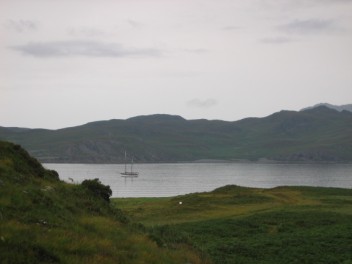
The seals are probably grey seals. We also have common seals in the UK, but contrary to what their name suggests, they are far from common. In the past seals were eaten and their hides and fur used for clothing, as they still are in hunter gatherer tribes in the Arctic. Seals have also suffered from distemper, but the likely most significant threat today is over fishing.
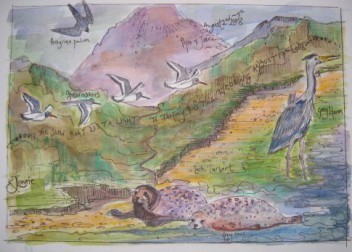
We jump in the dingy and row to shore. The water is surprisingly opaque for a Scottish Loch. It appears that Jura’s hills are weeping peat which rolls into the streams and out into the salt water. A band of white sand layers against the bracken slopes that abut grey boulder fields, beyond these, the great ‘paps’of Jura loom, like conical volcanoes.
David and I scramble over the hills through streams of clouds, with occasional glimpses back down to Lista Light, alone in the Loch. A forlorn whistle rises from the hillside and we snatch a glimpse of a golden plover. Golden plovers are also waders, nesting in the uplands in bogs, moors and pastures. The male has a spectacular summer plumage with a gold, flecked back and jet black apron. He runs backwards and forward on a ledge calling and bobbing. We saw them last year on Skye and before that in the forest of Bowland. A line of five of the speckled waders fly pass.
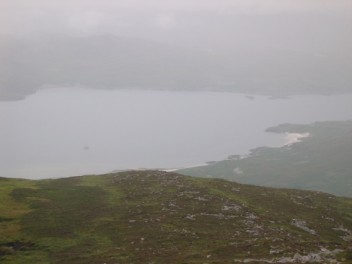
Meanwhile, Clare, who chose a lower path to explore the shore of the loch, is warding off the midge fraternity that have descended upon her in a cloud. Puffing roll-ups to keep them at bay she chooses the dingy back rather than contending with the marauders. This is her first run off with the fabled Scottish midge and it’s not a happy one.
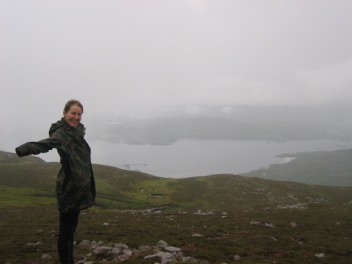
Day two, Dave and I are determined to run up the hills before the mist descends. Clare is still suffering from yesterday’s midge onslaught and chooses the safety of the boat. She is eyeing the brilo pad, anything to stop the frenzied itching.
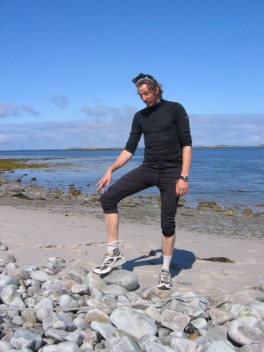
We pick minute ticks from our exposed limbs after thrashing through the bracken. Deer tracks scrawl the hillside providing a myriad of route ways for us to ascend the Jura bean stalk.
We reach top after top, rounding a ridge to find the horizon straddled by red deer. Red deer are indigenous to Scotland and would have been found throughout the UK. Today, very few herds remain in England, Exmoor being one such exception. They are the biggest of our native mammals, forming large herds, in contrast to the diminutive roe deer which are generally solitary. Other species of deer have been introduced to the UK or have escaped from private collections, including: fallow deer, muntjack and Chinese water deer.
Previously, red deer would have been hunted by wolves. Unfortunately, wolves were exterminated in the UK mainly due to conflicts between farmers and their livestock. With no natural predators, red deer populations have burgeoned, with shooting and stalking providing limited local control. The consequence of unchecked increases in deer populations is overgrazing, often reducing deer territories to bracken, mat grass and purple moor grass. Shrubs and trees are nibbled before they have a chance to grow, limiting niches for other species to flourish.
We finally reach the top of a ridge, a myriad of turquoise lochs, lagoons and craggy hills unfold before our eyes.
As we pick our way down the slope to the sea cliffs, a peregrine falcon suddenly swoops up from under our feet. He gains height, then, pushing his wings beside him, forms into an arrow and hurtles over the cliffs, piercing the sky at break neck speeds.
Nearing the beach, we leap into a stream and stick our heads in the pounding waterfall. Cream foam forms at the mossy edges. We float like logs towards the sea, sliding over the algae covered rocks.
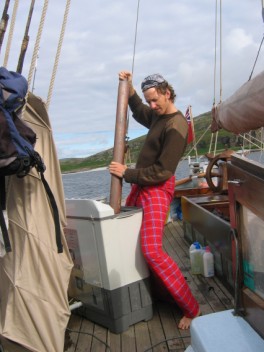
David is determined to find razor fish. He has heard how you are able to entice them from their haunts by salting the entrance to their borrows. The slight floor in the proceedings is that he is not entirely sure what their burrows look like!
I bob off to Lista in my holey wet suit. A seal nods at me, but startled by its own bravado, dives deep and disappears. Long fronds of kelp entangle my legs and my ‘white finger’ syndrome takes hold.
Clare has been learning chords on the guitar. We guzzle soup and watch Dabid stalking the strand line for razor shells.
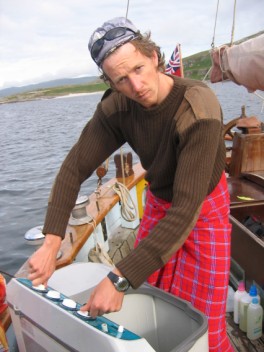
We clear the decks ready for departure. Nothing has really changed, the seals still laze over one another on the rocks, King gull stands on high, the shags take it in turn to slip into the water and the oystercatchers shuffle across the beach. The only new arrival is a juvenile black guillemot, which I haven’t seen before.
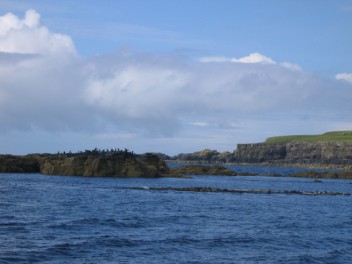
Back to previous section - Exeter (Devon, England) to Fishguard (Wales)
Forward to next section - West Coast of Scotland
This page hit Count : 5780
This is the Lista Light Website, for the travels of the sailing boat Lista Light
Click here for text-version of site